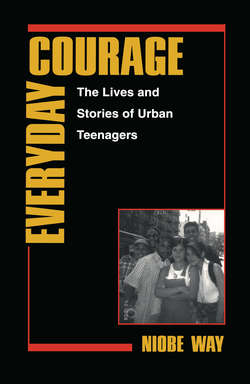Читать книгу Everyday Courage - Niobe Way - Страница 30
На сайте Литреса книга снята с продажи.
Part I
INDIVIDUAL LIVES
ОглавлениеIn this book, I present two case studies of adolescents who were interviewed over the three years of the project. Malcolm and Eva inspired and provoked me. As I listened to their stories, I was compelled to focus on them for my case studies. Malcolm, first interviewed by Mike in the spring of his freshman year, is presented in the first part of the book, and Eva, first interviewed by Helena in the spring of her sophomore year, is presented in the latter part of the book.
In these case studies, I describe what Malcolm and Eva said about themselves, their futures, their relationships to their mothers, fathers, sisters, brothers, friends, lovers, and role models, their school, and the larger society. In some respects, Malcolm and Eva are similar: both are black and live in the same neighborhood; both go to the same school; both live with their mothers; and both struggled academically at the beginning of high school only to finish on the honor roll. However, they are also different: Malcolm is African American and Eva, though raised in the United States, was born in the West Indies; Malcolm is relatively isolated from his peers while Eva is extremely popular; Malcolm is not involved in any extracurricular activities while Eva takes part in many. Their perspectives on their worlds, furthermore, differ as dramatically as the quality of their relationships.
In presenting these two case studies, I want to remind the reader of the complexity of each individual life. While the focus of this book is on the patterns detected across adolescent lives, it is important to remember that each adolescent had a different story to tell, and a different way of telling his or her story. I also want the reader to hear how the specific patterns I focus on in chapters 4 through 9 are a part of larger stories—the two case studies provide a context for the patterns. And finally, I want the reader to hear the wide-ranging and deeply moving stories that two adolescents told us when we asked them about their lives. Michelle Fine and Lois Weis emphasize the importance of representing the “mundane” or the “rituals of daily living.” They note that as socially responsible researchers we should “recognize how carefully we need not to construct life narratives spiked only with the hot spots … like surfing our data for sex and violence.”1 I present the details of two individual lives, in part, to avoid representing only the patterns, or the “hot spots,” in the data. In these case studies, I want to present the regularity and texture of everyday living.
Throughout the case studies, I frequently provide a verbatim account of Malcolm’s or Eva’s responses to our particular questions. Although I offer interpretations of their responses, my primary aim here is to have the reader hear the details of the lives of these two adolescents. Chapters 4 through 9 are structured around the patterns that I detected among the adolescents and the interpretations I have of these patterns. Consequently, these chapters leave little room for listening freely to their stories. I have chosen, therefore, to present the case studies in a format that is more conducive to open listening—listening that is less constrained by a specific interpretation, that lets itself be guided by the rhythms of the stories. I begin and end this book with a story of a life in progress.
